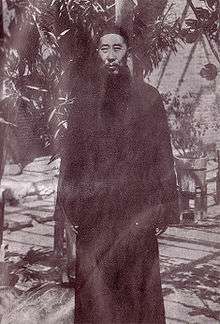Jin Shuren
Jin Shuren (traditional Chinese: 金樹仁; simplified Chinese: 金树仁; pinyin: Jīn Shùrén; Wade–Giles: Chin Shu-jen; c. 1883–1941) was a Chinese warlord who served as Governor of Xinjiang between 1928 and 1933.
Jin Shuren | |
|---|---|
金樹仁 | |
 | |
| Provincial Chairman of Xinjiang | |
| In office 7 July 1928 – 14 April 1933 | |
| Preceded by | Yang Zengxin (as Provincial Governor) |
| Succeeded by | Liu Wenlong |
| Commander-in-Chief of Xinjiang | |
| In office 7 July 1928 – 14 April 1933 | |
| Preceded by | Yang Zengxin (as Military Governor) |
| Succeeded by | Sheng Shicai (as Military Governor) |
| Provincial Commissioner forCivil Affairs of Xinjiang | |
| In office 1927–1928 | |
| Personal details | |
| Born | c. 1883 Tao-ho, Gansu, Qing Empire |
| Died | 1941 |
| Nationality | Han Chinese |
| Military service | |
| Allegiance | China |
| Years of service | 1928–1933 |
| Rank | Provincial Commander-in-Chief |
Biography
Jin Shuren was born in Gansu. He graduated at the Gansu provincial academy and then served as the Principal at the provincial normal school. He entered the Imperial Civil Service, where he got into the attention of Yang Zengxin, at the time District Magistrate of Hezhou. When Yang was appointed Governor of Xinjiang in 1908, Jin followed him as a district magistrate. After the collapse of the Qing dynasty in 1911, Jin rose through the ranks during Yang's absolute rule over Xinjiang. In 1927 he was named Provincial Commissioner for Civil Affairs in Ürümqi, a post which he held until Yang's assassination in July 1928.[1]
After taking the Yang's post, Jin sent a telegram to Nanking asking for Kuomintang's recognition of his new post. Kuomintang had no other choice but to recognise Jin as a new governor, but under new terminology he was recognised as Provincial Chairman and Commander-in-Chief, unlike his predecessor Yang who held the titles of Provincial Governor and Military Governor.[1]
Immediately after taking power, Jin took steps to strengthen his power by increasing the secret police, doubling the salaries of army and police and introducing new uniforms. The army was later expanded and new weapons were acquired. The administrative system remained almost unchanged, while Jin employed the practice of his predecessor of appointing relatives and fellow provincials. Subsequently, former Yunnanese officials, both Han and Hui were replaced by Han from Gansu, especially from the region of Hezhou. He appointed his brother Jin Shuhsin as Provincial Commissioner for Military Affairs and another brother Jin Shuchih was given a senior military post in Kashgar.[2]
Jin expanded Yang's system of internal surveillance and censorship. Besides increasing the strength of both secret and ordinary police, he introduced internal passports which gave him greater control over internal travels thus tightening internal security, as well as giving additional source of revenue for his administration. Traveling outside the province became almost impossible.[3]
In 1932, the French Yellow Expedition passed through Xinjiang. Jin's provincial authorities hindered their advance.
Jin's rule of Xinjiang for about a half-decade was characterized by strife caused by corruption, suppression and disruption. Ethnic and religious conflicts were intensified and resulted in numerous riots against his regime and his eventual downfall. Jin confiscated the local Turkic lands in order to redistribute them to the Chinese, but he gave these lands to his personal associates. The deception caused the Chinese to become the targets of hatred. Jin also favored the Han over the Turkic (such as the Uighurs) and intensified ethnic conflicts between the Uighurs and Chinese. In April 1933 Jin's White Russian troops changed allegiance, encouraged revolt in Xinjiang, ended his reign and forced him to flee to the USSR. He was succeeded by Sheng Shicai.[4] Jin incurred the wrath of the Kuomintang (KMT) when, without approval, he signed an arms treaty with the Soviet Union. The Tungan General Ma Zhongying allied himself with the KMT and his troops became the 36th Division of the National Revolutionary Army (NRA). Ma was ordered to overthrow Jin.[5] Jin however, was overthrown after the First Battle of Urumqi (1933) by White Russian troops under Colonel Pavel Pappengut. When he returned to China in October 1933 he was arrested by the KMT, brought to trial in March 1935 and sentenced to 3-1/2 years imprisonment. However, the KMT pardoned him on 10 October 1935 and he was released from prison the next day.[5][6][7]
Footnotes
- Forbes 1986, p. 38.
- Forbes 1986, p. 38–39.
- Forbes 1986, p. 39.
- Starr 2004, p. 71.
- Forbes 1986, p. 106.
- Aitchen Wu, Aichen Wu (1984). Turkistan Tumult. Oxford University Press. p. 278. ISBN 0-19-583839-4. Retrieved 2010-06-28.
- Who's Who in China; Biographies of Chinese leaders. Shanghai: THE CHINA WEEKLY REVIEW. 1936. p. 52.CS1 maint: ref=harv (link)
References
Books
- Forbes, Andrew D. W. (1986). Warlords and Muslims in Chinese Central Asia: A Political History of Republican Sinkiang 1911–1949. Cambridge, England: Cambridge University Press. ISBN 9780521255141.CS1 maint: ref=harv (link)
- Starr, S. Frederick (2015). Xinjiang: China's Muslim Borderland. Abingdon-on-Thames: Routledge. ISBN 9781317451372.CS1 maint: ref=harv (link)
| Wikimedia Commons has media related to Jin Shuren. |